The words “full moon” in many languages

It is said that there are more than 6,000 languages worldwide (this is hard to imagine) and it is a fascinating concept to think, there are probably as many words for “full moon”.
Here we begin our little journey to the full moon. A few words about the fascinating quest of the greater purpose, that includes the full moon circulating through our lives. In layman’s terms and not always scientific (astronomy experts – don’t look too closely!). We would like to wish you illuminating moments. Enjoy!


It is said that there are more than 6,000 languages worldwide (this is hard to imagine) and it is a fascinating concept to think, there are probably as many words for “full moon”.
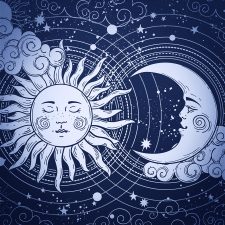
A full moon is when the Sun and the Moon are facing opposite, being in opposite direction from an Earth perspective.
This might feel astonishing if one imagines that the Moon is on one side, the Sun on the other and the Earth in between? Shouldn’t the Earth throw a shadow onto the Moon? Bingo – this is exactly what she does! But only when the Moon is exactly on the Earth orbit, the so called “ecliptic”. When this takes place, we speak of a lunar eclipse!
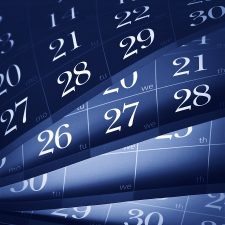
The Moon needs 27.33 days to circle around the Earth. Something that is also referred to as “sidereal time”. But because the Earth orbits the Sun, just like the Moon orbits the Earth, the Moon has to travel two further days in order to resume the same position to the Earth and Sun. This is then called the “sidereal time”. In order to determine the point of time of the reoccurring full moon, the sidereal time serves as basis.
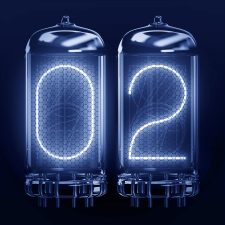
We already know now that the moon month is mostly shorter than the calendar month, being on average approximately 29.5 days. If full moon falls on the first or second of a month, it is possible that another full moon occurs in the same month, for instance in July 2004:
Friday, 2 July 2004, 01:08:54 pm
Saturday, 31 July 2004, 08:05:06 pm
This event is also known as “blue moon”.

The answer is: “everywhere at the same time”. This refers to the so called Universal Time (UT) though, which is used for general astronomical events. We have already learnt that full moon is an astronomical event, where the moon, sun and the earth play a role by being in a specific position. So, full moon takes place at a specific time in the outer space. This point of time is specified by astronomers namely by the Universal Time.

There are multiple ways of approaching this question. If we look at it from a purely theoretical standpoint, we might be tempted to say that the full moon is infinitely short, since the phases of the moon are changing continuously. The moon is not yet quite full shortly before the full moon, and is already waning shortly afterwards.
However, there is a practical aspect that lets us quantify the full moon as a finite and measurable span of time: Since the Sun is significantly bigger than the Moon, its rays are able to reach just a little over half of the Moon’s surface. This means that the timespan in which the visible side of the Moon’s surface is irradiated (as seen from Earth) is longer than infinitely short.

Whether scientists, astrologers or esoterics, they agree on one thing: the moon influences earth and life on earth. For instance, it regulates the tides through its magnetism. Also continents feel the consequence of this magnetism and either raise or lower their position sometimes up to 26 cm.

In nature it is a known fact: for some animal species, mating takes place at full moon. However, the examples that can be found on this subject are rather simple. Full moon serves in some cases indirectly as the cause (for instance through the high water levels during the tides that the horseshoe crab uses to deposit its eggs) or also as the signal for both sexes of a species to begin at the exact same time to safeguard their future existence (a particular type of fly or also corals). It is understood that also wolves are led by full moon when it is time to mate.

… that people are looking for an argument at full moon or are especially happy …
… that if full moon is surrounded by a haze, a person dies …
… that you raise your hat three times to the moon (being a man) or you make a curtsey (being a woman), in order to protect yourself from misfortune until the next full moon …
… that whoever does not chink glasses with full moon at least once, does not deserve any happiness [Greek toast] …
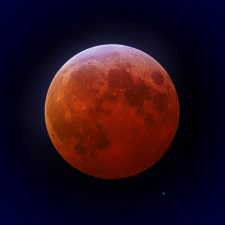
During a lunar eclipse, the Moon moves through the shadow of the Earth. Which means, that the Earth is positioned quite exactly between the Sun and Moon and casts its shadow onto the Moon. This is only possible at full moon and if some other requirements are met. Depending on whether the moon passes the partial or the core shadow of the Earth, we speak of a partial or total lunar eclipse.
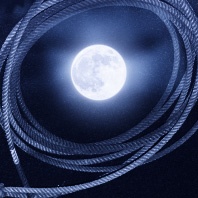
There are movies that live on Mount Olympus. The movie “It’s a wonderful life” by Frank Capra from 1946, belongs to them. However, at the time of the release, shortly before Christmas of the aforementioned year, this had not been the case yet. Commercially, this movie was a flop and did not turn into a cult movie until decades later. Today, the story about George Bailey (played by James Stewart), who does many good deeds in a small American town, quarrels with his destiny on Christmas Eve and eventually, through meeting an unconventional angel, learns to recognise the value of life, is considered to be one of the best movies in motion picture history.
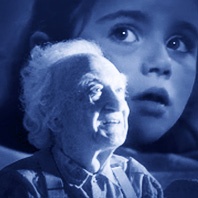
The Christmas advertising campaigns of the well known English department store John Lewis, have developed into a yearly tradition since their start in 2007 and have become part of pre-Christmas Internet culture. John Lewis has been awarded the “IPA Effectiveness Award” with its 2012 Christmas campaign. This year, the video called “Man On The Moon” was published – parallel to the Christmas full moon on 25th December 2015.

The Belgium painter René Magritte (1898–1967) was next to Salvador Dalí, one of the most influential painters of surrealism. This denotes a style in art (and in other areas), which has tried to use dreamlike, fantastical and absurd elements as techniques of expression for a new superior reality, since the 1920s.
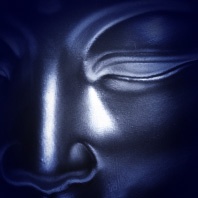
Today is full moon and for many Buddhists this is a special day, because the Vesak holiday is celebrated worldwide. According to tradition, Buddha was born on full moon in May, later became enlightened and also passed away on this day. This is how this day is honoured in countries like Singapore, Vietnam, Thailand, Indonesia and also in India, Nepal, Sri Lanka and many more. And above all of this, the full moon shines.
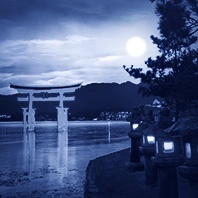
Japan has a custom, which is called “Tsukimi” or also “Otsukimi” that literally means “moon-viewing” (tsuki = jap. Moon). This tradition dates back to the Heian period (794–1192) where Japanese culture and the arts were refined to a high degree. At that time, elements of the Chinese “Mid-Autumn Moon Festival” were introduced in Japan, and festivals and rituals were held in the eighth sun month (which corresponds to September in our current calendar).
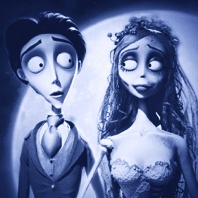
Fitting in with today’s full moon and the forthcoming events of Halloween, we dedicate this article to the stop motion movie »Corpse Bride« (2005) by Tim Burton, the master of bizarre and subtle productions. The movie is based on a Russian legend »Corpse Bride« and captures the story of a wedding between two people of varying social backgrounds (Victor & Victoria) or rather differing worlds (Victor & Emily), with the resulting tension.

Shortly before Easter, we are taking a look at Christianity and notice that a very important event must have taken place at the full moon: the Last Supper of Jesus and his disciples. From a historical point of view, the Last Supper derives from the Jewish Passover feast (Seder), which traditionally takes place on the eve of Passover. This meal is being celebrated on the 14th Nisan, which is always the first full moon after the spring equinox – the beginning of spring. This is how later, the calculation of the Easter date had been determined: »Easter takes place on the Sunday after the first full moon in spring.«

Looking at the Moon, you can recognise the spots on the surface with the naked eye, which are termed lunar maria and have always been inspiring people’s imagination. It is actually molten rock that rose to the surface during the origin of the Moon and then hardened. If looked at closer and using a telescope as an aid, you are able to make out mountains and valleys and a large amount of craters. In short: they are landscapes that give our Moon its face.
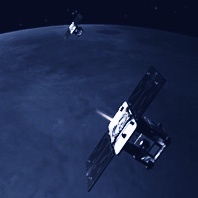
A probe is an unmanned flying object, which explores space. Different to a satellite, a probe does not circle the Earth but flies to other celestial bodies, which they circle, too, but are then called orbiters. Two of these probes have been on the way to the Moon since 10th September 2011, to take measurements with unprecedented accuracy. The GRAIL lunar probes have reached the orbit of the Moon as planned, at the turn of the year 2011/12 and are now currently at work, until they will shatter on the Moon’s surface. In the meantime, they will have transmitted lots of data back to Earth.
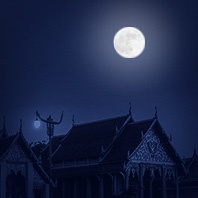
Māgha Pūjā is an important Buddhist holiday that is celebrated in Thailand, Laos, Cambodia, and Sri Lanka, on the day of the full moon, in the third month of the Thai moon calendar, in February/March. The word Māgha refers to month and Pūjā is the honoring. Legend has it that on this day 1,250 monks congregated to meet with Buddha.